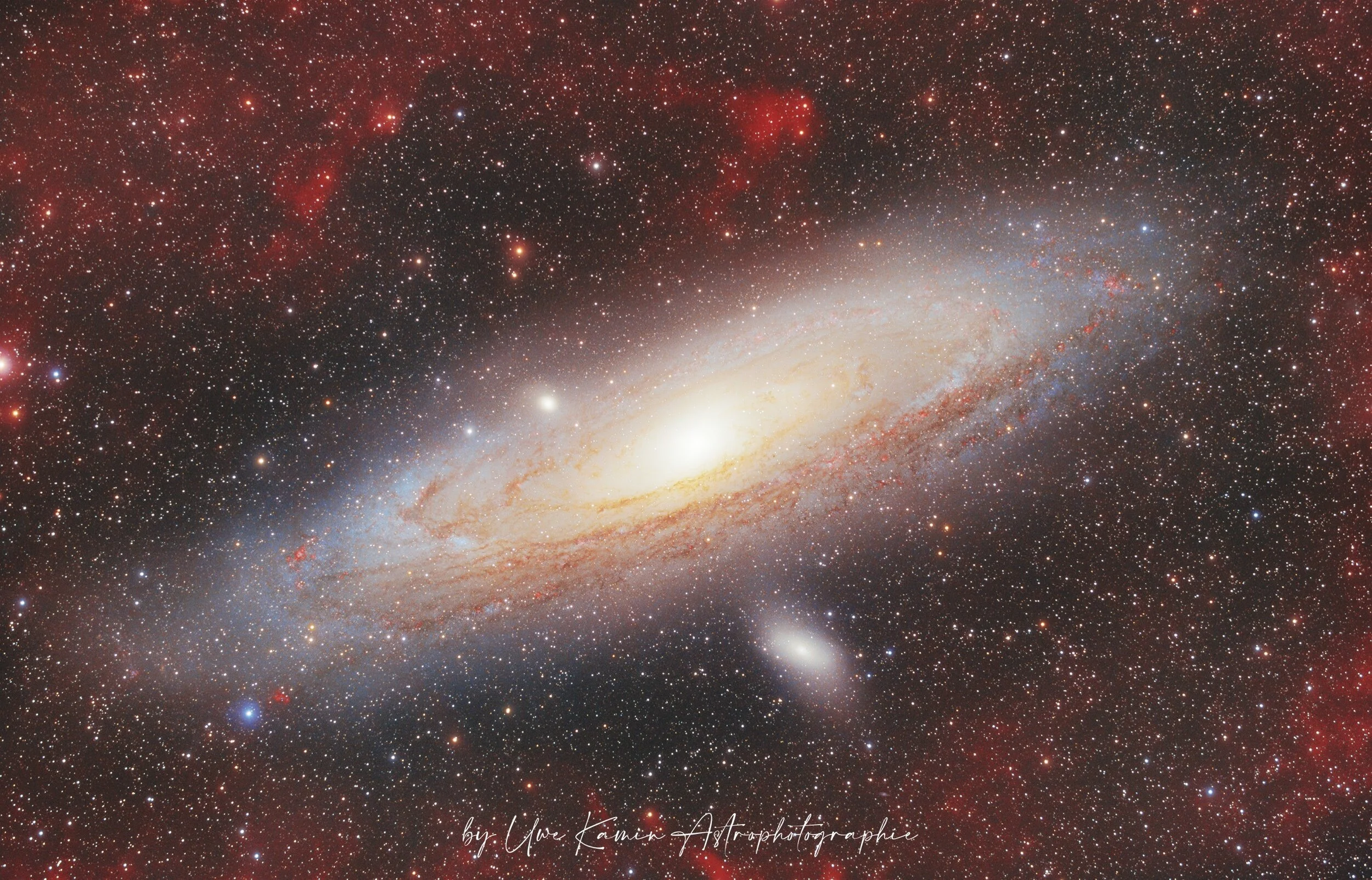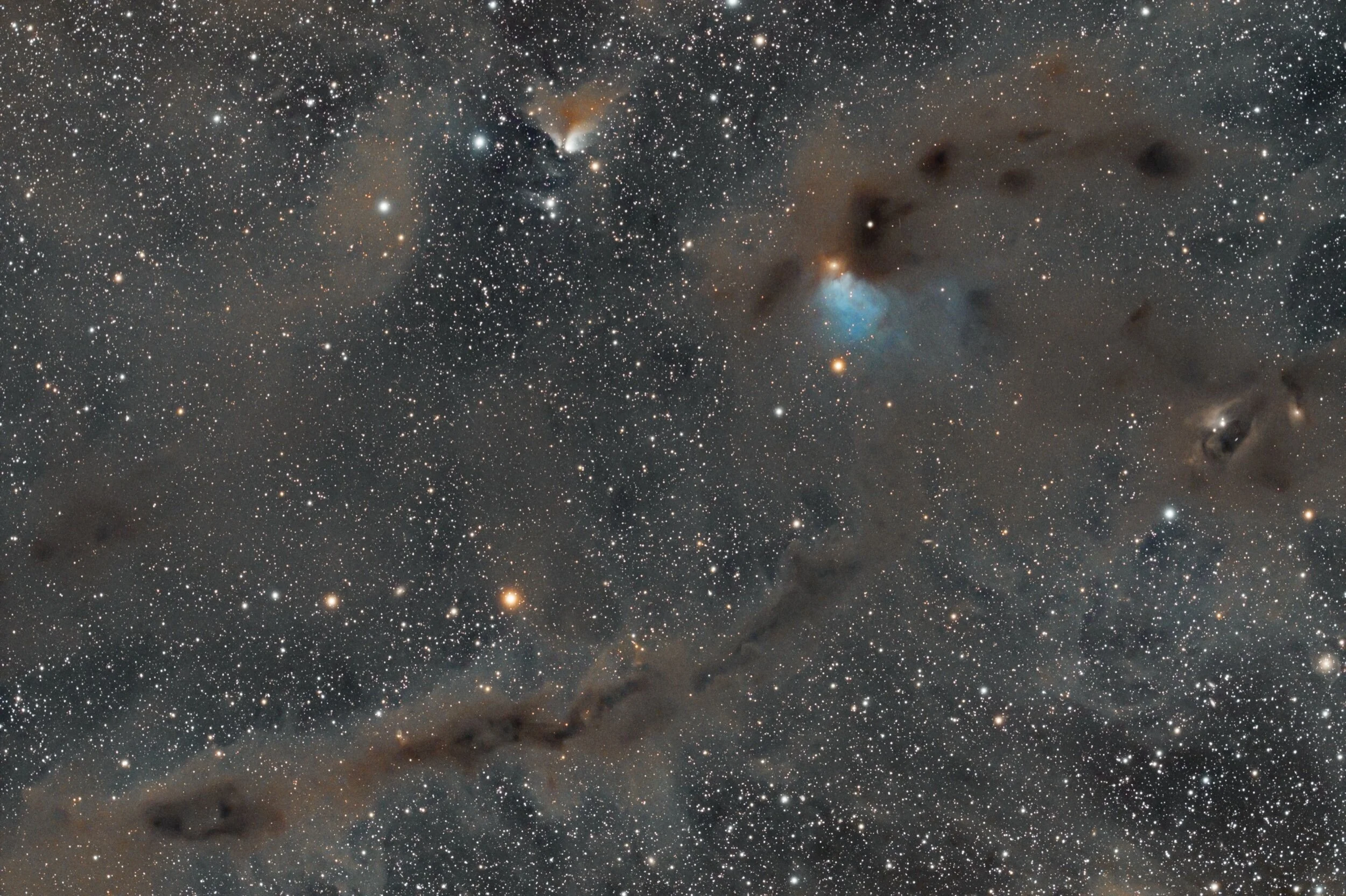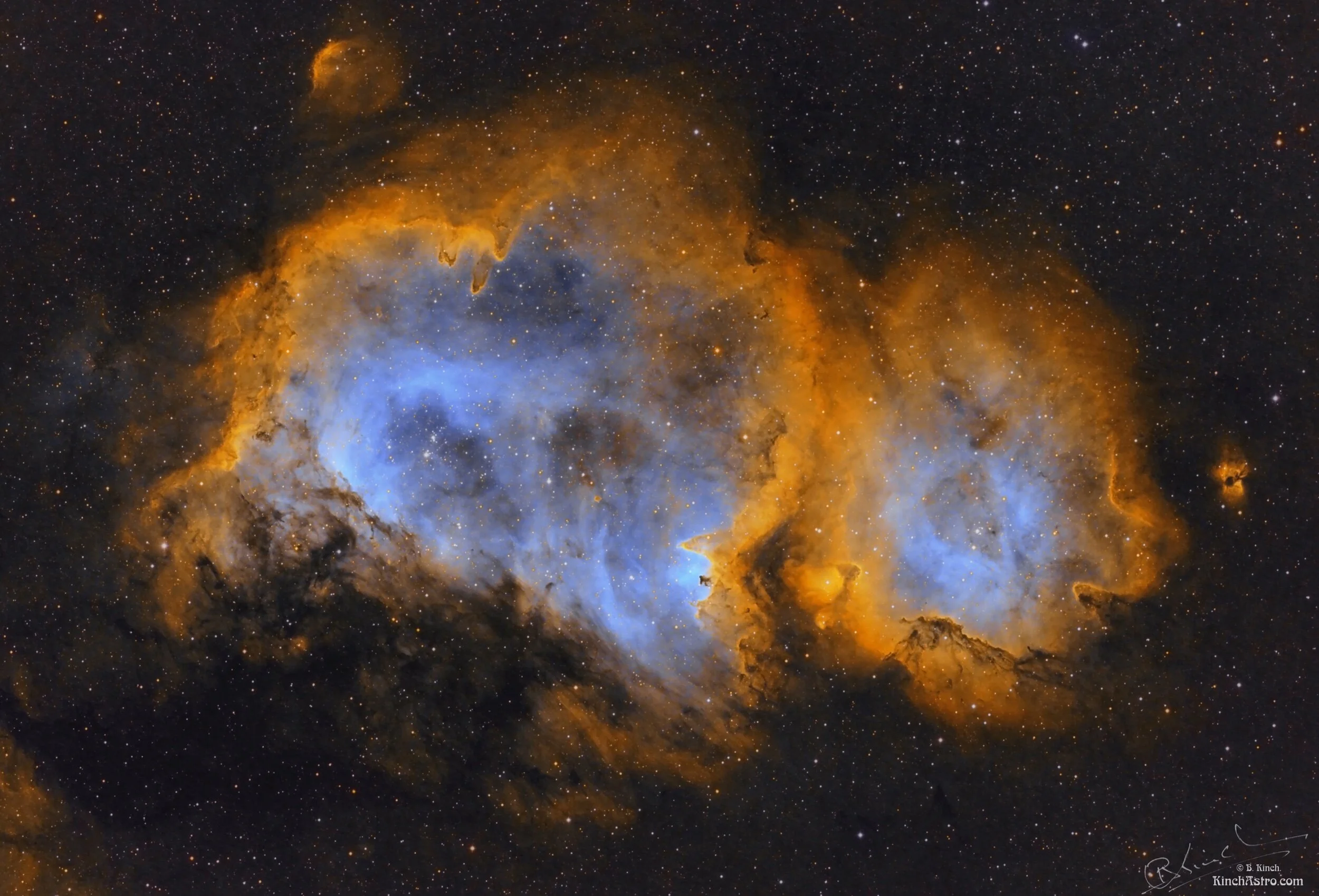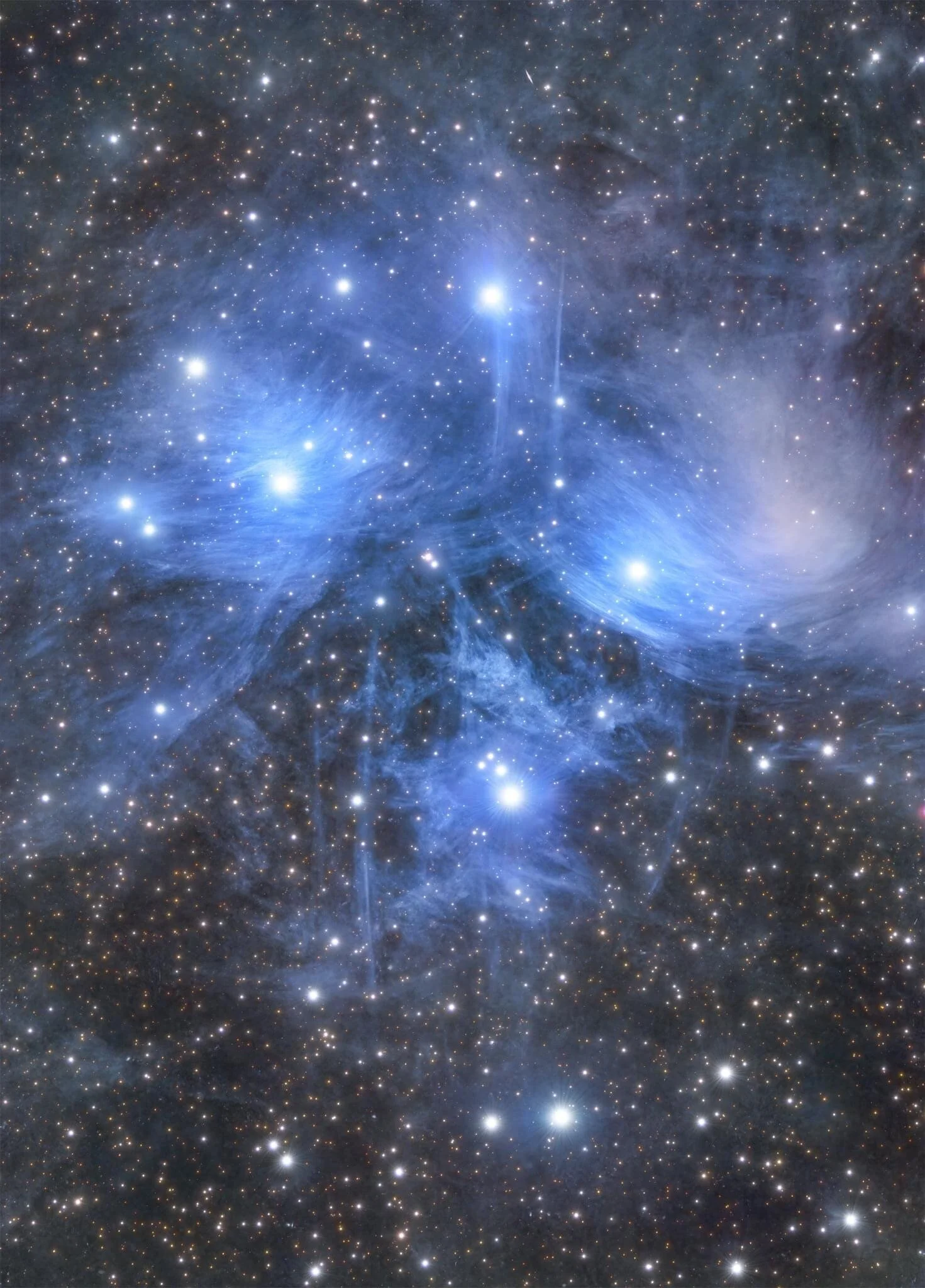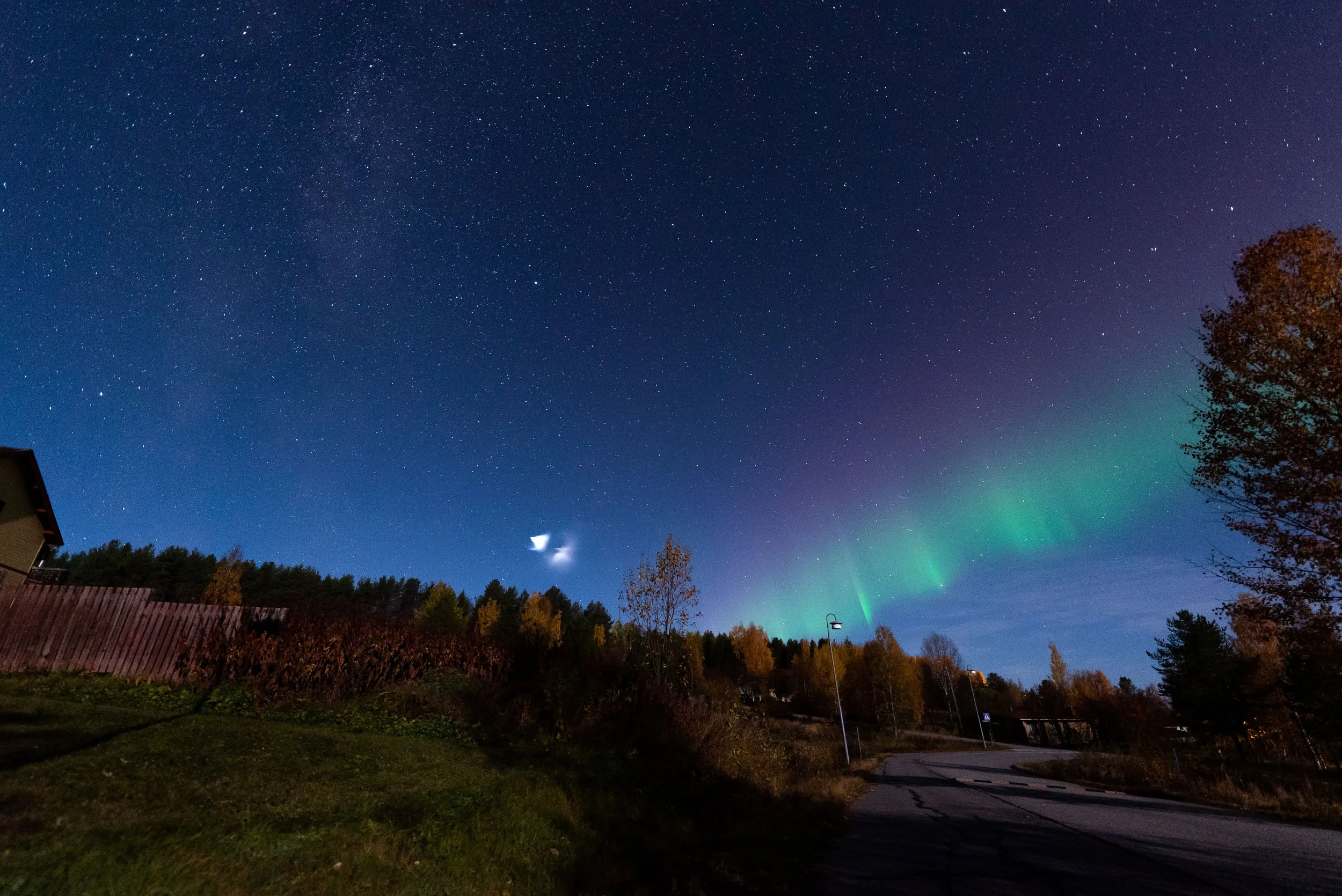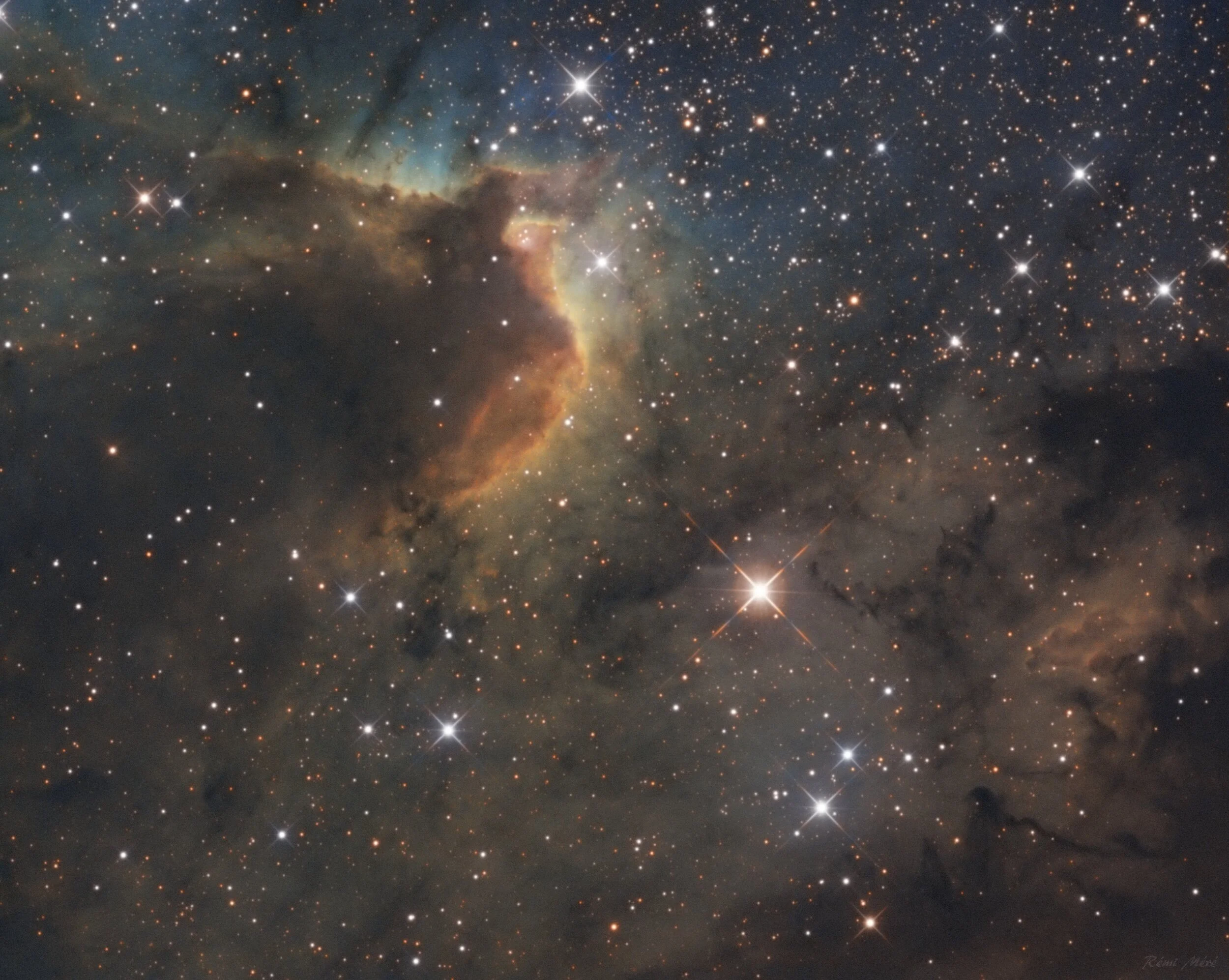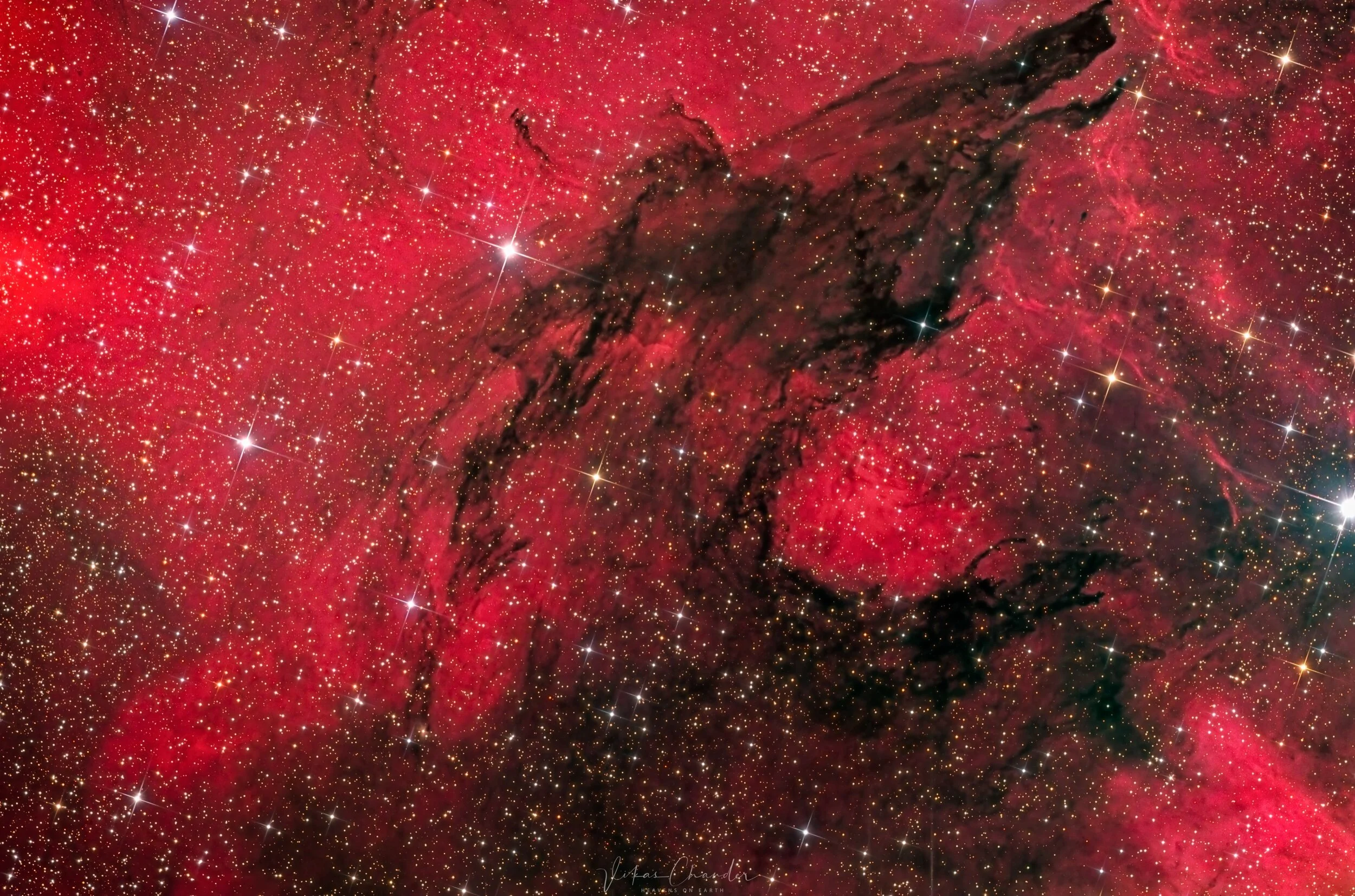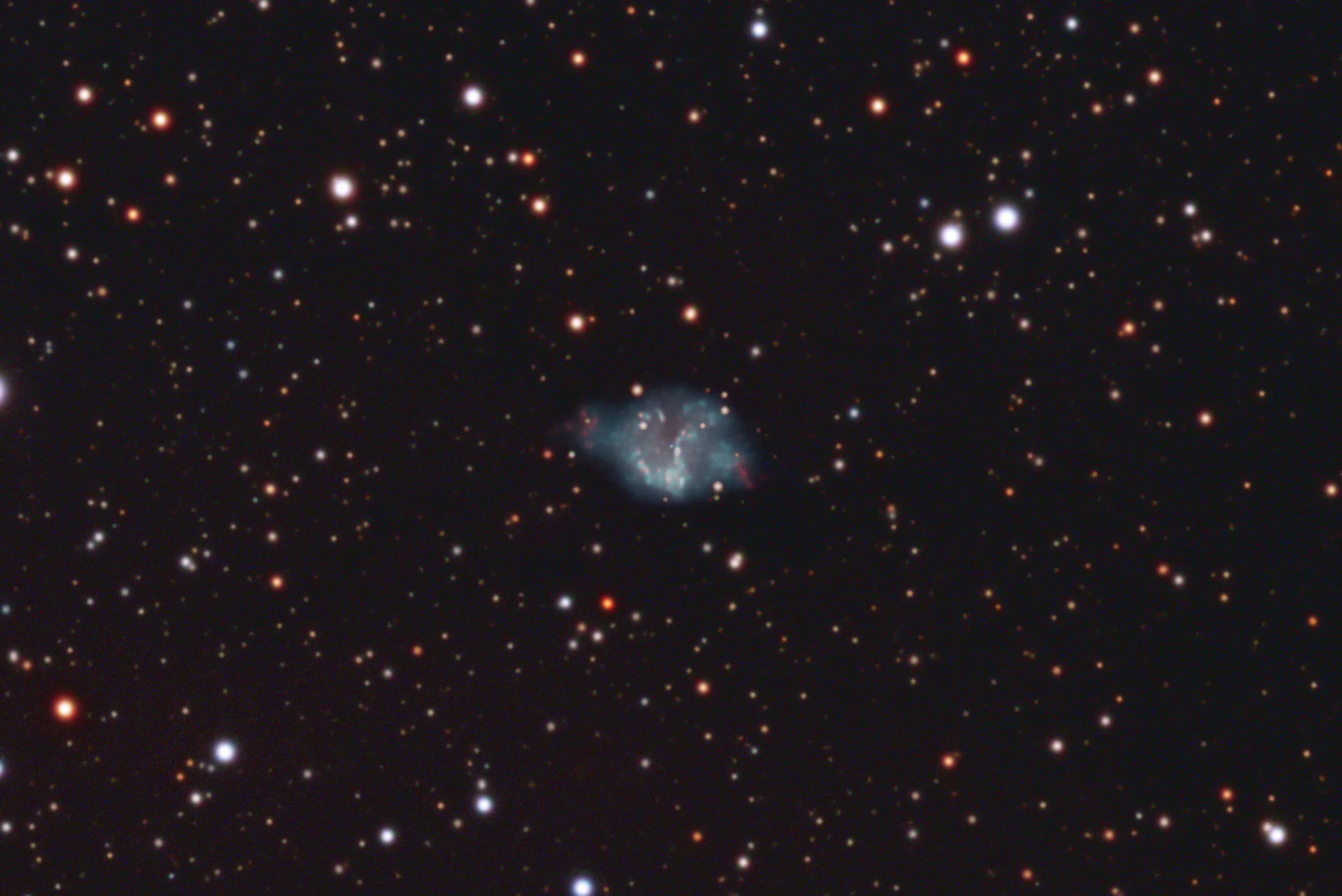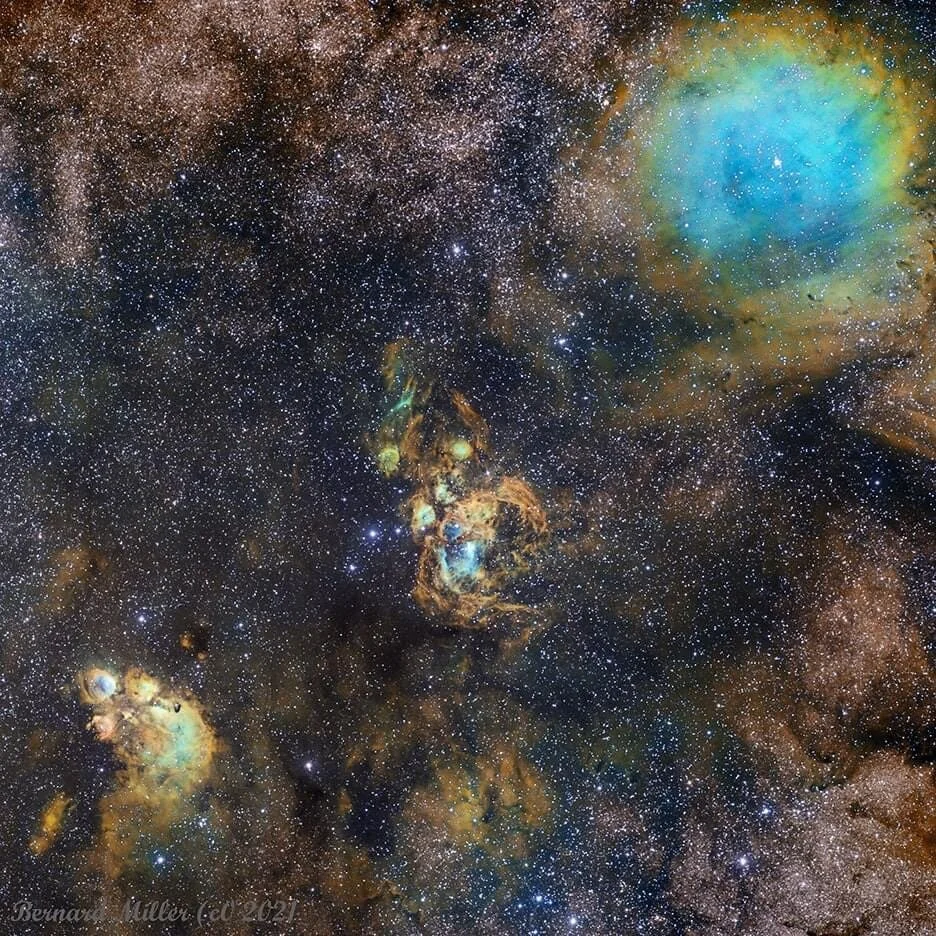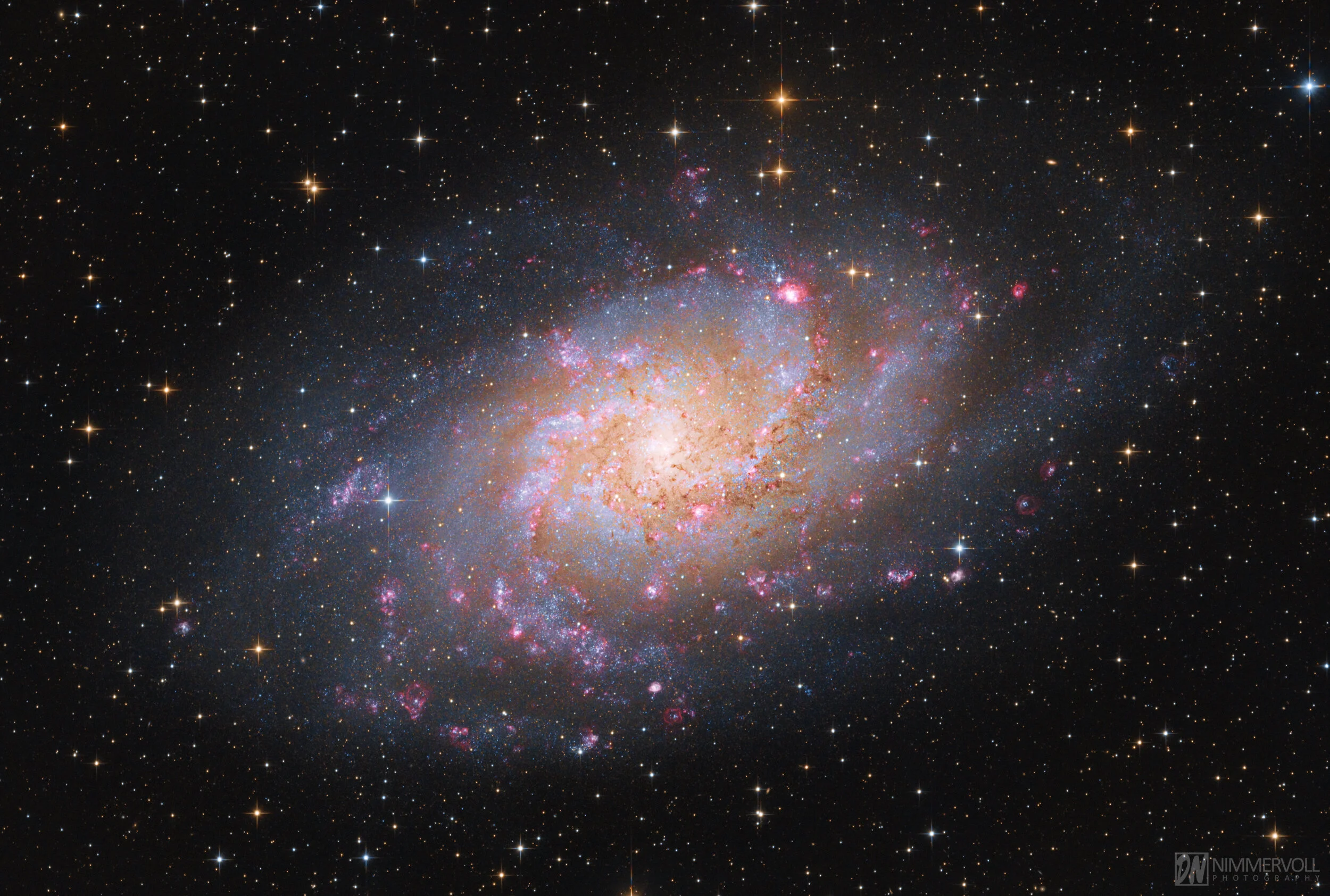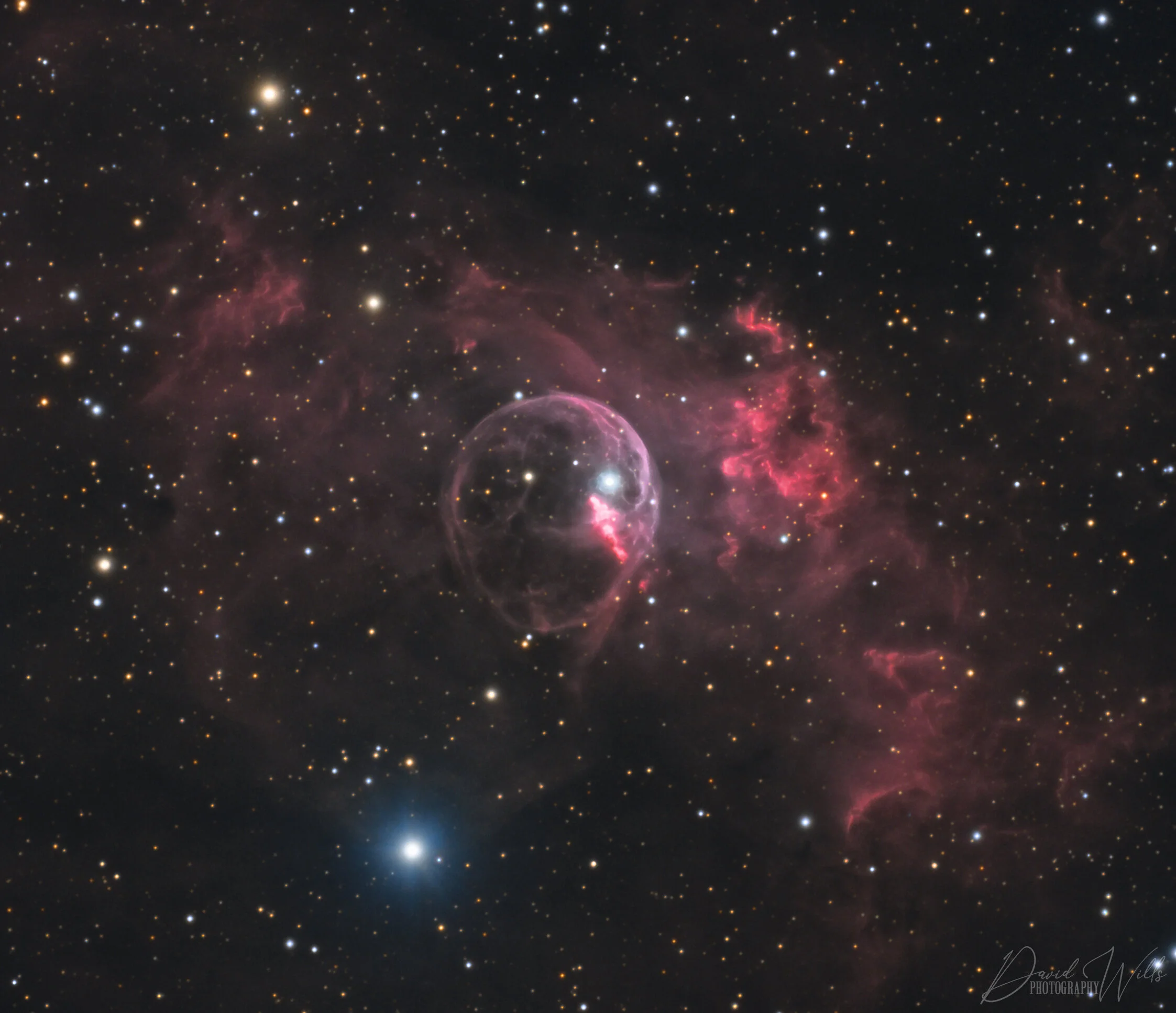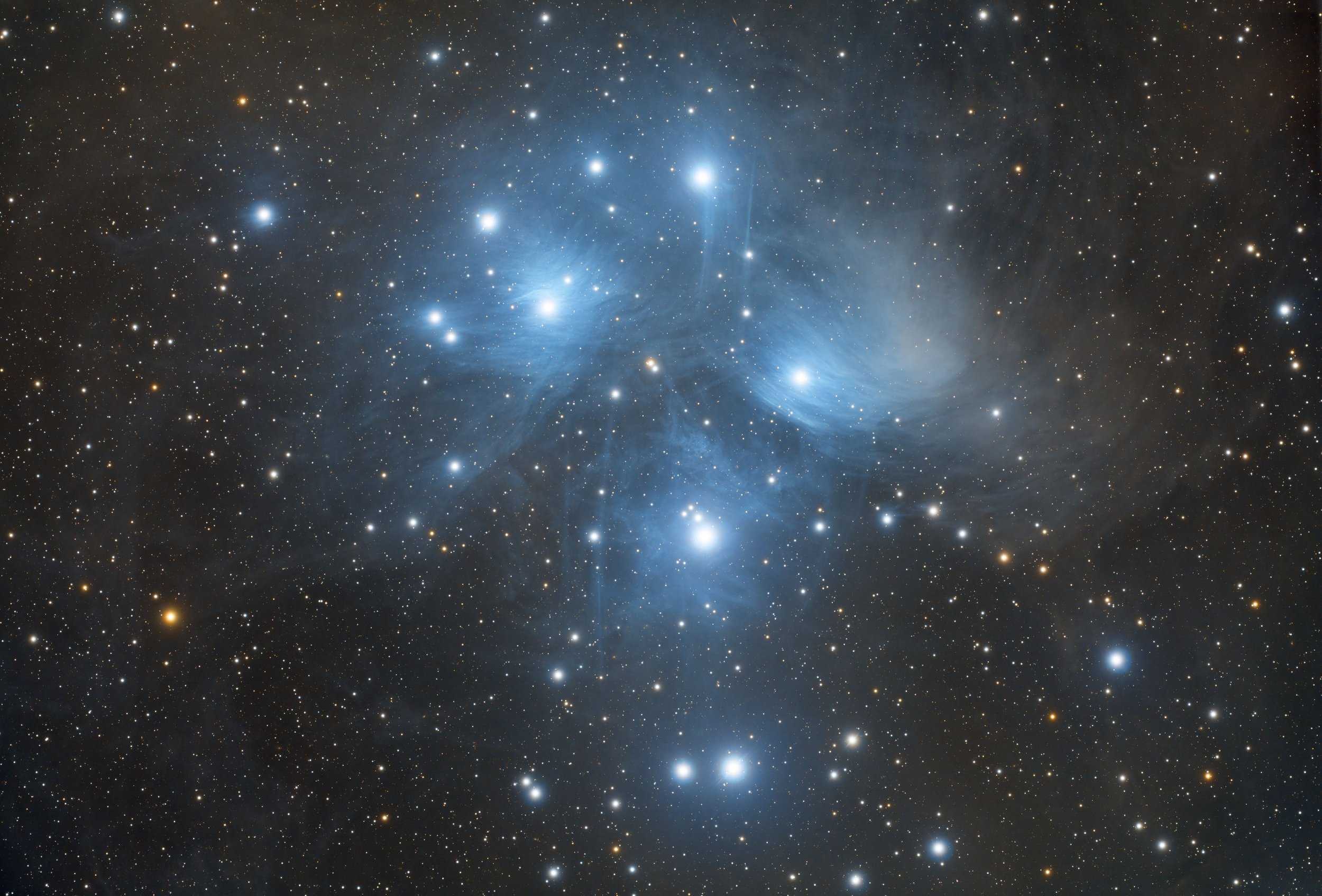
AAPOD2 Image Archives
LOBSTER CLAW & BUBBLE NEBULA
The LOBSTER CLAW (SH2-157) & BUBBLE NEBULA (SH2-162), or Sharpless 157 (Sh2-157), is an emission nebula, around 12,000 light-years from Earth between the Cassiopeia and Cepheus constellations. There are several interesting features in this nebula rich region, including the Bubble Nebula, NGC 7635 (or Sh2-162), a HII region emission nebula which lies in a surrounding shell, and excited by the star SAO 20575. Also in the frame are the Wolf-Rayet massive star WR 157, two large open clusters of stars NGC 7510 and NGC 7654, and the nebula NGC 7538, which is home to the largest yet discovered protostar, 300 times the size of our solar system! This image was captured over the span of a week totaling 14.2 hours in narrowband. Each filter was mapped to the Hubble Palette. OTA: William Optics GT81 using 0.8x Flat6A-81 reducerMount: Celestron CGX-LCamera: ZWO ASI294MM ProGain: 100 Night 13nm Sii 22x600s3.7 hours Night 27nm Oiii 30x600s5 hours Night 33nm Ha 22x900s5.5 hours 14.2 hours total Cooling Temperature: -10 CelsiusAuto-guiding: ZWO ASI174MM Mini and ZWO M48 OAGControl: ZWO ASIAIR Pro Flagstaff, AZ - Bortle 4 skies Calibrated in Astro Pixel Processor with darks and flatsProcessed in Pixinsight and Lightroom
Copyright: Copyright: Drew Evans
M31 The great Andromeda galaxy in hydrogen dust
Image Description and Details : M31 dans sa robe de soirée. 19H15 d'exposition, dont 6H20 en Ha.
38 Ha de 10 min
65 Luminances de 5 min et 50 poses de 3 min sur chaque canal RVB
Lunette TS 86/464 Quadruplet APO astrographe
Réducteur Televue x0.80
Focale 371mm à F 4.3
Monture EQ6 Pro
Autoguidage Lunette Orion 50mm Guide Scope 163mm
Camera Starshoot Autoguider
Imageur ZWO ASI2600MM Pro
Roue à FiltreZWO 7*36MM
Filtre Baader L, R, V, B ,S2, Ha et O3
Sky Quality 19.95
Magnitude CLASS 5 Bortle
SGP SEQUENCE GENERATOR PRO, SIRIL et UWE ASTRO TOOLS
Copyright: by Uwe Kamin Astrophotographie
Dark Salamander
Image Description and Details : ASI 2600c + Sharpstar 94mm APO. About 5.5 hours total.
Copyright: Dave Dev
fornax dwarf galaxy
This is the Fornax Dwarf Galaxy from an advanced request I did at telescope.live. I had to split it over 2 different nights to get it all due to issues with acquisition and while I didn't get all the luminance I intended it still turned out decent to me.
This is 3x 600s L, 5x 600s, R, 5x 600s, B, and 5x 600s G taken with an FLI PL16083 through Astrodon LRGB filters and an ASA 500N f/3.6.
Copyright: Scotty Bishop
Soul Nebula
This complex is the eastern neighbor of IC1805 (Heart Nebula) and the two are often mentioned together as the "Heart and Soul". Located about 6,000 light-years from Earth, the Heart and Soul nebulae form a vast star-forming complex that makes up part of the Perseus spiral arm of our Milky Way galaxy. The Soul nebula is also known as the Embryo nebula, IC 1848 or W5.The Perseus arm lies further from the centre of the Milky Way than the arm that contains our sun. The Heart and Soul nebulae stretch out nearly 580 light-years across; the diameter of the Milky Way, is roughly 100,000 light-years across.Imaging telescope: Takahashi FSQ130EDImaging cameras: FLI ML16200Mounts: Takahashi EM 400 Temma 2MGuiding cameras: QHY CCD QHY 5 IIFocal Extender / Reducer: Tak QE 0.73x Software: PHD 2, Astro Pixel Processer, PixInsight , Sequence Generator Pro SGPFilters: Astrodon Ha + Astrodon OIII + Astrodon SIIAccessories: ATIK EFW3Original Resolution: 3500 x 2500 Dates: Sep 15 - Oct 5, 2021Frames:Astrodon Ha: 42 x 600"Astrodon OIII: 42 x 600"Astrodon SII: 42 x 600"Integration: 21 Hours.Center (RA, Dec): (43.568, 60.344)Center (RA, hms): 02h 54m 16.291sCenter (Dec, dms): +60° 20' 38.560"Size: 2.52 x 1.8 degRadius: 1.551 degPixel scale: 2.6 arcsec/pixelOrientation: Up is 180 degrees E of N
Copyright: Brendan Kinch
m45
M45 - Pleiades: The Seven Sisters Star Cluster.
…lies about 444 light years away toward the constellation of the Bull (Taurus). A common legend with a modern twist is that one of the brighter stars faded since the cluster was named, leaving only six of the sister stars visible to the unaided eye. The actual number of Pleiades stars visible, however, may be more or less than seven, depending on the darkness of the surrounding sky and the clarity of the observer's eyesight.
Tech card:
Imaging telescope: Explore Scientific 127mm ED TRIPLET APO.
Imaging camera: ZWO ASI294MM-Pro.
Mount: iOptron CEM60.
Guiding camera: ZWO ASI290MM mini.
Focal reducer: Explore Scientific 0.7 Reducer/Flattener.
Accessory: ZWO OAG · ZWO EAF Electronic Auto Focuser · ZWO ASIAIR Pro · ZWO 8x 1.25" Filter Wheel (EFW).
Frames: Astrodon Gen 2 LRGB E Series: 80x120" (2h 40' ) (gain: 120.00) -20C bin 1x1.
Integration: 2h 40'
Darks: 50.
Flats: 30.
Flat darks: 30.
Avg. Moon age: 3.55 days.
Avg. Moon phase: 13.62%
Bortle Dark-Sky Scale: 4.00.
RA center: 03h46m41s.
DEC center: +24°09′32″
Pixel scale: 0.706 arcsec/pixel.
Orientation: 91.368 degrees.
Field radius: 0.943 degrees.
Re-process of my data of Feb. 15, 2021.
Imaging location: Abu Dhabi desert, UAE.
Copyright:Wissam Ayoub
NGC7822
NGC7822, Sh2-171. This is an object that I have been wanting to re capture for several years now. My first complete image with the new William Optics FLT91.Technical cardImaging telescopes or lenses: William Optics FLT91mmImaging cameras: ZWO ASI 294 MM Pro Cooled Mounts: iOptron CEM120Guiding telescopes or lenses: William Optics Guidestar 61mmGuiding cameras: ZWO ASI 120mm mini Focal reducers: William Optics 0.8 reducer/flattnerSoftware: SharpCap Sharcap 3.2.60 · Stark Labs PHD2 · QHYCCD Pole master · Pleaides Astrophoto PixInsight · N.I.N.A.Filters: Astronomik 6nm Ha · Astronomik 6nm OIII · Astronomik 6nm SIIAccessory: AstroZap Dew Heater Straps · Pegasus Astro Ultimate Powerbox V.2 · Moonlite focuser 2.5 inch Focuser with high resolution stepper motor Dates: September 26-28 2021Frames:Astronomik 6nm Ha: 131x180" (gain: 120.00) bin 1x1Astronomik 6nm OIII: 90x180" (gain: 120.00) bin 1x1Astronomik 6nm SII: 103x180" (gain: 120.00) bin 1x1Integration: 16.2 hoursDarks: ~50Flats: ~50Flat darks: ~50Locations: Remote site: Fredonia, Al., Lanett, Alabama, United States
Copyright: Altum spatium Astrophotography
Rocket launch, auroras & milky way
Image Description and Details : A rocket launch was visible in Finland on night 27-28-9-2021 and I saw the first time it appeared on the sky from a sky camera. Then I suspected it could be visible again in about 90 minutes. I waited for it and was rewarded with a photo I am very satisfied with.
Copyright: Dennis Lehtonen
Sh2-155
Image Description and Details :
Baader B 1.25" filtre bleu: 25x300" (2h 5') -10C bin 1x1
Baader G 1.25" filtre vert: 25x300" (2h 5') bin 1x1
Baader Ha 7nm: 93x300" (7h 45') -10C bin 1x1
Baader R 1.25" filtre rouge: 25x300" (2h 5') bin 1x1
Badder OIII 8.5NM: 90x300" (7h 30') -10C bin 1x1
Badder SII 8nm: 127x300" (10h 35') -10C bin 1x1
Intégration: 32h 5'
Copyright: Rémi Méré
SL17 Wolf Nebula
Image Description and Details : There are few objects of particular note in Lupus, the Wolf constellation, but one of them is this very opaque dark nebula, which lies in the foreground and blocks out the light from thousands of stars beyond. This nebula belongs to the group of 42 dark dust clouds of high visual opacity which are referred to by the initials "SL" in some atlases.
Telescope : Planewave CDK 17 F6.8
Camera : SBIG STXL 11002
Mount: Software Bisque Paramount ME
Pixel scale : 0.63 arcsec/pixel
FOV : 42 x 29 arcmins
Filters :HaLRGB
Integration: 14h30m
Ha 10x30m
L 12x15m R 9x15m G 8x15m B 9x15m
RA center: 16h 03m 29s
DEC center: -42°01′51″
Copyright: Vikas Chander
PM1-333
Image Description and Details : PM1-333 is a small (70 arc seconds) planetary nebula in the constellation Cepheus. It was discovered by Andrea Preite-Martinez in 1988. I believe this to be the deepest, and highest resolution colour image of this target. The tiny blue progenitor star can just be made out dead centre of the image.
It lies within IC1396 where it appears as a small dot at the bottom left hand corner in J-P Metsavainio's excellent image https://1.bp.blogspot.com/-JEMi-QvpB0Q/XicHMRDQXbI/AAAAAAAARug/ECBNZGRTptwRSAOExQSKmmvCIZWz6niCACLcBGAsYHQ/s1600/IC1396Det.jpg
Image captured on my remote dual rig at Fregenal de la Sierra in Spain between 20-30 September 2021.
Scopes: APM TMB LZOS 152 Refractors
Cameras: QSI6120wsg8
Mount: 10Micron GM2000 HPS
A total of 54 hours image capture (HaOIIILRGB)
Copyright: Peter Goodhew
Cederblad 111
Image Description:
This is an image of Cederblad 111. It is a nebula complex about 500 light years away in the constellation Chamaeleon. Cederblad 111 refers to the blue reflection nebula near the center left of the image. You can also see the reddish nebula GN 11.07.3 at about the ten o'clock position relative to the blue reflection nebula. If you zoom in really close, you can just make out the Herbig-Haro objects: HH 49 and HH 50 at about the five o'clock position relative to the blue reflection nebula. The entire Chamaeleon I cloud covers an area of 5 square degrees and, at this distance, is one of the closest regions of star formation to the Earth.
Copyright: Bernard Miller
NGD 6357, NGC 6334, and RCW 133
Image Details:
September 19, 2021
Location: Yass, NSW, Austrlia
Telescope: Takahashi FSQ-106EDX4
Camera: FLI PL16803
Mount: Paramount MX+
Ha: 26x10 minutes (binned 1x1)
OIII: 26x10 minutes (binned 1x1)
SII: 31x10 minutes (binned 1x1)
Copyright 2021 Bernard Miller
The pillar of Cepheus (VdB 152)
Image Description and Details :
This cosmic pillar stretches for approximately 1,400 light years along the northern part of the Milky Way, in the constellation Cepheus. Near the edge of the large molecular cloud, pockets of dust block all light from the stars in the background or weaken the light of the brightest star at the top, this star giving the nebula its characteristic blue color.At the bottom right of the image is a planetary nebula LBN 538 (red / blue). Discovered in 1979 and first described in an article in 1980 by Dengel, Hartl and Weinberger.ASA Newton 250/950 F3.6Paramount MyTZWO ASI2400MC à -10°C + rotateur ArteskyIDAS LPS-P3 et IDAS NBZ Nebula BoostSkywatcher Evostar72ED + ASI120MM miniTheSkyX pro, MaxPilot, FocusMax, AstroPixel Processor, PixInsight, Photoshop44h5' (68x 900” Filtre NBZ, 83x300" et 121x600" Filtre LPS-P3)Lorraine, France31 August, 1er, 2, 3, 4, 5, 7 et 8 September 2021
Copyright: Thomas LELU
The Alpha and Omega
Image Description and Details : This cosmic landscape depicts Sh2-115 and Abell 71, the first an emission nebula and the latter a planetary nebula. Or, in other words, the birth and the death of stars - hardly anything else more meaningfull to us.
Image shot in narrowband, 13 hours in Ha and 22 hours in O3, during July and August 2021, being the last frame of Aug.19th. Equipment as follows:
Telescope: TS PhotoLine Triplet APO 115/800mm
Camera: QHYCCD 163M
Filters: Baader OIII 8.5nm 36mm · Baader Ha 7nm 36mm
Mount: Sky-Watcher EQ6-R Pro · Skywatcher AZ EQ5-GT
Copyright: André Vilhena
M33
Image Description and Details :RECORDING DATA:
Location: Upper Austria
Object: Messier 33
Photo taken in: September 2021
Distance: 2.8 million light years
Diameter: 60,000 light years
Exposure: 203 x 300 sec. For RGB24 x 900 sec. For dual narrow band
Total: 23 hours
Calibration: Darks / Flats / DarkFlats
Mount: Skywatcher EQ6-R PRO
Telescope: Lacerta Fotonewton 250/1000
Corrector: Lacerta GPU coma corrector
Filter: Astronomik L2 UV-IR Block 2 ″ Optolong Filter L-eXtreme 2 ″
Camera: QHY268c @ Gain 0/60 at -15 ° C
Guiding: ZWO OAG with QHY5III462c and PHD2
Software: APP / Photoshop CC
Copyright: Daniel Nimmervoll
Ic 1318
Image Description and Details : IC 1318 taken in South Portugal.
IC 1318 also called the Butterfly Nebula, is a nebula in emission in the constellation Cygnus.
It is a huge nebula in emission, quite bright and distinct, in the shape of a circumflex accent, rather difficult to see, but which appears easily on photographs. It has in its center a dark nebula. It spreads around the bright star Sadr (γ Cygni). It is located in the Milky Way, thus on a background rich in stars.
Equipment:
-FSQ 106 scope on Eq6 Skywatcher Pro mount
-Camera Asi 1600MM
Ha=14H30
O3=10H48
S2=10H
Total Time: 35H
Copyright: Team Aro
NGC 7635 The Bubble Nebula
Image Description and Details : NGC 7635 The Bubble Nebula captured by David Wills at PixelSkies, Castillejar, Spain
Red 583 x 30s
Green 1483 x 30s
Blue 468 x 30s
Ha 74 x 300s
21 hrs 8 mins hours in total.
Equipment used:
Telescope: Celestron 8" Edge HD
Camera: Xpress Trius SX-694 Pro Mono Cooled to -10C (Binned x2)
Image Scale: 0.8
Guiding: OAG
Filters: Astronomik Ha
Mount: iOptron CEM60 "Standard" GOTO Centre Balanced Equatorial Mount
Image Acquisition: Voyager
Observatory control: Lunatico Dragonfly
Stacking and Calibrating: Pixinsight
Processing: Pixinsight 1.8, Photoshop CC
Copyright: David Wills
IMPACT on the planet Jupiter
Image Description and Details : IMPACT on the planet Jupiter
=========================
On 13.09.2021, I made a series of exposures to the transit of the IO satellite over the planet Jupiter.
Towards the end of the observation session, I noticed a large rapid spark in the IR filter, but I did not realize its importance until, the next day, the Brazilian amateur observer José Luis Pereira also discovered it in his captures and
he made it public. The seeing was good that night, but at the time of the impact it had dropped considerably.
Processing was required to combine the exposures made on the IR filter, in which the impact occurs, with the rest of the filters,
green and blue, to achieve a color image. The capture was made with a monochrome ZWO ASI 290MM camera, the exposure video being 2000 x3 frames on each filter.
The derotation of the SER videos was performed in the WinJUPOS program, the total duration being 14 minutes.
Although I am the beginning of the exposures to the planets, being focused on the deepsky pictures, I think I was very lucky to catch this event.
I want to thank Dm. astrophotographer Pepe Mera, for the tips related to the optical part, which have a lot in mind in the realization
exposures to planets.
Clear sky!
Telescope: Celestron Edge HD11
Camera: ZWO ASI 290MM
Fara Barlow
Filters: Optolong IR Pass 685nm filter
Astrodon G, B Gen2 E Tru-Balance filters
Frames: 2000x3x3 (28 fps)
Mount: EQ6R Pro
Processing: AutoStakkert, RegiStax, WinJUPOS, Photoshop
Details Jupiter:
Visual magnitude: -2.8
Diameter: 48.0 "
IO Satellite Diameter: 1,221 "(Visual Mag: 5.1 Mag)
Altitude: 24 °
Azimuth: 35 ° [SW]
Clear sky!
Cosmin Sandu
GAAP Group of Amateur and Professional Astrophotographers
Copyright: Sandu Val Cosmin
Vdb 141
The Ghosts Temple In The Sky (Vdb 141)
Total 29h 55min in 7 nights - L 65x900s, R 57x300s, G 50x300s, B 57x300s (L bin 1x1, RGB bin 2x2). RC250 @ f/5.5, ASI2600MM, CEM60, Astrodon filters
Acquisition : APT - Astro Photography Tool (www.astrophotography.app), PHD2
Processing: PixInsight
The Cepheus constellation part of the sky shows part of the Milky Way that host several star forming regions. One of the molecular clouds which spreads from 600 to around 1400 light years away from Earth and is named Cepheus Flare. Near one of Flare edges is the beautifully formed nebula vdB-141 also known as Sh2-136. “vdB” comes after Sidney van den Bergh who discovered the “dark” nature of the object in 1966. “Sh2”comes after from the second edition of Stewart Sharpless emission nebulae catalog published in 1959. It also has popular name “Ghost Nebula”.
Being part of star forming region means that many things are happening. It is a reflection nebula that shines with the light of several stars embedded in it, most obvious is the one in the central blob. In right dark part there is cone shaped area – this is a Bok globule cataloged as CB230. The Bok globules are dark clouds in process of condensing and forming protostars. CB230 is considered to be producing a binary star system. The same place is also cataloged as Herbig Haro object HH 157. The Herbig Haro objects are nebulae around newborn stars that are formed in the nearby clouds by the ionized gas jets emitted by the young stars. It is an interesting area described in the results of different sky surveys.
Copyright: Ivaylo Stoynov
